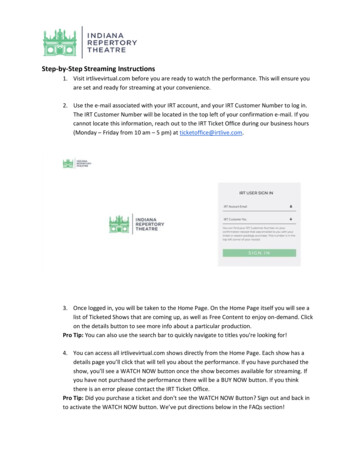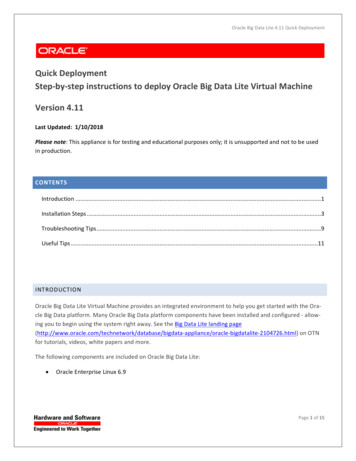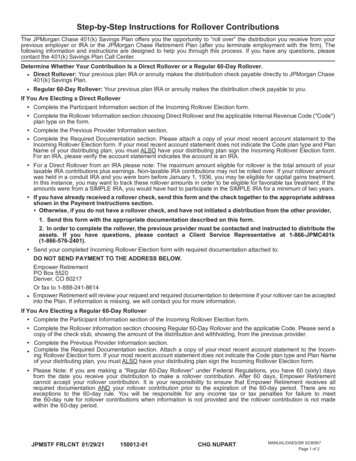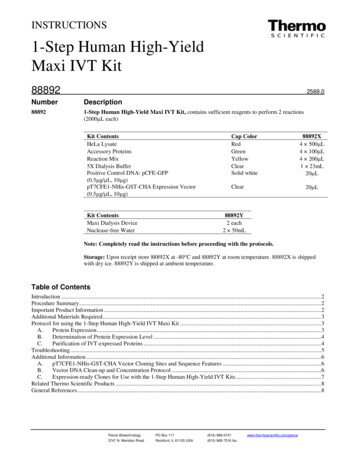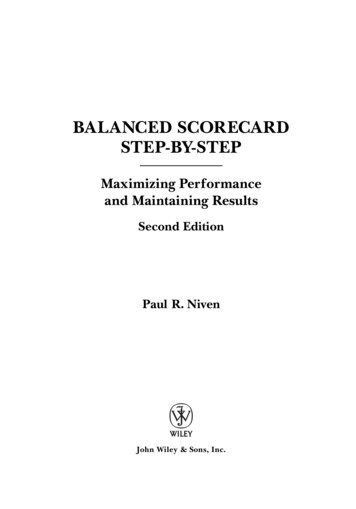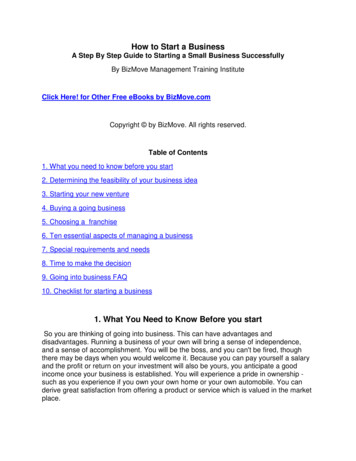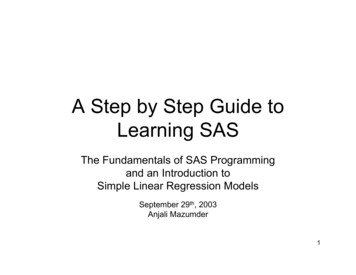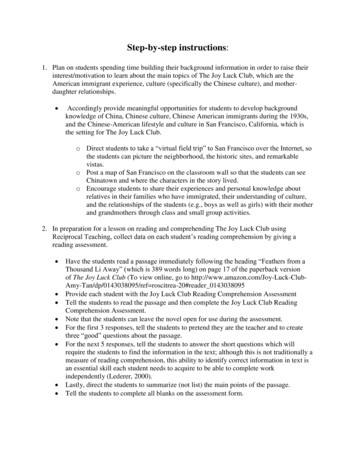
Transcription
Step-by-step instructions:1. Plan on students spending time building their background information in order to raise theirinterest/motivation to learn about the main topics of The Joy Luck Club, which are theAmerican immigrant experience, culture (specifically the Chinese culture), and motherdaughter relationships. Accordingly provide meaningful opportunities for students to develop backgroundknowledge of China, Chinese culture, Chinese American immigrants during the 1930s,and the Chinese-American lifestyle and culture in San Francisco, California, which isthe setting for The Joy Luck Club.o Direct students to take a “virtual field trip” to San Francisco over the Internet, sothe students can picture the neighborhood, the historic sites, and remarkablevistas.o Post a map of San Francisco on the classroom wall so that the students can seeChinatown and where the characters in the story lived.o Encourage students to share their experiences and personal knowledge aboutrelatives in their families who have immigrated, their understanding of culture,and the relationships of the students (e.g., boys as well as girls) with their motherand grandmothers through class and small group activities.2. In preparation for a lesson on reading and comprehending The Joy Luck Club usingReciprocal Teaching, collect data on each student’s reading comprehension by giving areading assessment. Have the students read a passage immediately following the heading “Feathers from aThousand Li Away” (which is 389 words long) on page 17 of the paperback versionof The Joy Luck Club (To view online, go to 038095/ref roscitrea-20#reader 0143038095Provide each student with the Joy Luck Club Reading Comprehension AssessmentTell the students to read the passage and then complete the Joy Luck Club ReadingComprehension Assessment.Note that the students can leave the novel open for use during the assessment.For the first 3 responses, tell the students to pretend they are the teacher and to createthree “good” questions about the passage.For the next 5 responses, tell the students to answer the short questions which willrequire the students to find the information in the text; although this is not traditionally ameasure of reading comprehension, this ability to identify correct information in text isan essential skill each student needs to acquire to be able to complete workindependently (Lederer, 2000).Lastly, direct the students to summarize (not list) the main points of the passage.Tell the students to complete all blanks on the assessment form.
Allow 30 minutes for the students to read the passage and complete the Joy Luck ClubReading Comprehension Assessment.Use Scoring Key for Joy Luck Club Reading Comprehension Assessment to assessstudent performance.Then discuss results with each student individually and obtain a written commitmentfrom student to learn Reciprocal Teaching so that the student improves her or his abilityto comprehend text.3. Discuss that in order to read effectively a student must learn how to interact with the text todiscern what the author is conveying both directly and indirectly. Note that good readers have learned more than one strategy or trick to help themcomprehend what they will read.Emphasize that while reading skilled readers will question what they read, summarizewhat the main points are, identify and clarify what did not make sense, and predict whatwill come next.Tell the students that they will be learning a reading activity to improve their readingand listening comprehension by utilizing four strategies usually used by expert readersto improve how students interact with the text and to develop their problem-solvingskills.By learning how to implement Reciprocal Teaching, each student will become moreconfident in their reading skills and may use it in other courses.4. Then discuss and assist each student set her or his goals for learning the four strategiesutilized during Reciprocal Teaching with specific date for completing phases of training.5. Plan on teaching Reciprocal Teaching during 45-min classes over the course of severalweeks until the students no longer require your support.6. Assist each student to set quality and quantity goals with respect her or his readingcomprehension.7. Create a slide and poster as follows:
7. While displaying the slide to the students on a whiteboard by a computer, tell the studentsthat Reciprocal Teaching is composed of four strategies.8. Describe Reciprocal Teaching through each of the four strategies utilized (questiongenerating, summarizing, clarifying, and predicting), the general situations where ReciprocalTeaching can be used (to improve reading and listening comprehension), the benefits thestudents can expect from learning and utilizing Reciprocal Teaching (improve the quality ofyour content knowledge), and the guidelines, cautions, or exceptions for using ReciprocalTeaching, such as when students will watch a DVD of The Joy Luck Club or listen to a taperecording of The Joy Luck Club or their classmate reads it aloud.9. Describe, and model talking aloud each strategy to be incorporated in Reciprocal Teachingemphasizing that as the students gradually assume the teaching role working with theirclassmates and the teacher in small groups to comprehend what they read in the novel,discussions with classmates will increase and discussions with the teacher will decrease. Note that the first strategy is question-generating with regard to the main idea so thata student must create four or five questions a teacher might ask to assess what thestudent knows about a paragraph or segment of a text.oEmphasize that a student will understand the text read more thoroughly if sheor he creates questions about the material read and then self-tests using thosequestions.o Note that a student must identify the concepts mentioned in the text by askingand answering who, what, when, where, and how questions.
o Model how to identify main points in the novel using the passage immediatelyfollowing the heading “Feathers from a Thousand Li Away” (which is 389words long) on page 17 of the paperback version of The Joy Luck Club(which is the passage each student read for the reading comprehensionassessment).o Model how to ask others in one’s small group for information that would helpa student‘s understanding as well as the understanding of others in one’sgroup. Note that the second strategy is summarizing wherein a student must integrate thecontent of the novel across paragraphs and sections in the passage follow thefollowing five rules: o Delete triviaDelete redundancy,Superordinate (so that subcategories are subsumed under a morecomprehensive category) , andSelect topic sentence orInvent topic sentence where one was not explicitly stated in aparagraph or segment.Model how to put the main points in the novel together in summary formusing the passage immediately following the heading “Feathers from aThousand Li Away” (which is 389 words long) on page 17 of the paperbackversion of The Joy Luck Club (which is the passage each student read for thereading comprehension assessment).Note that the third strategy is clarifying wherein a student is to identify what does notmake sense to the student with the goal of clarifying it.o Model recognizing why the text may be difficult to comprehend, such asexposure to new concepts, unfamiliar vocabulary, and obscure associationswithin the text.o Model talking aloud how a student will anticipate barriers to understandingthe author’s intended meaning and act by rereading the text, using context foridentifying the meaning of an unfamiliar word, asking for help, looking up aword in the dictionary, etc. Note the fourth strategy is predicting wherein a student is to predict what the nexttopic might be in the next paragraph or segment of text.o Model how to use the main points and summary of the passage immediatelyfollowing the heading “Feathers from a Thousand Li Away” (which is 389words long) on page 17 of the paperback version of The Joy Luck Club(which is the passage each student read for the reading comprehensionassessment) to predict where the story will go.
10. Divide the students into heterogeneous groups of four and assign one of the followingreciprocal teaching roles to each 11. Tell students to get into their assigned groups.12. Distribute one note card (with one of the four roles written on it on one side with theReciprocal Teaching slide cited above on the other side) to each member of the group identifyingeach person's unique role.13. Hand out a Reciprocal teaching note taking sheet and a Reciprocal teaching worksheet toeach student.14. Direct the students to read a passage of three to four pages in four chunks of paragraph byparagraph depending upon her or his reading level while completing the Reciprocal teachingnote taking sheet followed by the Reciprocal teaching worksheet.15. Note that the segments will be read silently, orally by students, or orally by the teacherdepending on the decoding ability of each student.16. Note that each student will take notes using the Reciprocal teaching note taking sheet tocomplete the Reciprocal teaching worksheet.17. Following the reading of each chunk or paragraph of the chapter, ask each student to think ofa question or questions that could be asked about the selection, such as if there wereoooounclear parts,puzzling informationconnections to other concepts already learned, andmotivations of the characters, agents, or actors, etc.18. Call on one student to provide a question.19. Model how to refine the question.20. Encourage others to join in refining the question or raising another question.21. Note that later the Questioner within each group will undertake this role.22. Model how to summarize the chunk or paragraph that has just been read in accordance withthe five rules.
23. Encourage the students to refine the summary.24. Note that later the Summarizer within each group will summarize the passage.25. Model how to identify and make sense of confusing parts (including words, associations, orconcepts) of the passage read it.26. Encourage the students to assist in identifying what does not make sense to them with thegoal of clarifying it.27. Note that later the Clarifier within each group will undertake this role.28. Model how to think ahead and predict what the author will be sharing next and where thenarrative will take the reader.29. Encourage the students to assist in predicting the plot in the next section of the novel.30. Note that later the Predictor within each group will undertake this role.31. Note as you teach the four strategies to your students the importance of modeling the fourcomprehension strategies in context with the text being used for class so that the studentsrecognize the value of each strategy while you gradually transfer the responsibility for applyingeach strategy to the students providing encouraging feedback and ongoing evaluation.32. Repeat this process for each paragraph or section having the students switch roles by passingthe role card each possesses to the person to the right.33. Guide and support the groups and group members to learn how to implement the strategiesand undertake all four roles decreasing your leadership until each group can perform reciprocalteaching entirely without the need for support and involvement.34. Direct students to glue a copy of Reciprocal Teaching on to index cards with a glue stick andthen tape the index cards to her or his desk or in their English journal.35. Tell students that they must memorize the strategies included in Reciprocal Teaching soremind them to work on learning how to utilize all four strategies throughout the days/weeks oflearning Reciprocal Teaching.36. Note that over time students will phase out their need to refer to Reciprocal Teaching tapedon the student’s desk or in the student’s English journal and on a poster in the classroom and touse Reciprocal Teaching.37. Have student self-assess their reading comprehension using the Scoring Key for Joy LuckClub Reading Comprehension Assessment to evaluate their comprehension on a passage deeper
in the Joy Luck Club after several weeks of learning Reciprocal Teaching.38. Using technology, teach each student how to chart her or his performance using an Excelspreadsheet recording the sums earned on each of the three elements rated, i.e., createdquestions, answers to questions, and summaries. Have students use graph paper if using Excel isnot an option.39. Chart collected data from students and data you collected through observation.40. Review data from student and the data you collected with student independently.41. Congratulate students on their hard work, and review with them their goals for next time.42. You may wish to have students volunteer to read their summaries to the class or post thesummaries for all students.43. Assist students in generalizing the use of Reciprocal Teaching by first leading a discussionwith the students to identify and plan to use the strategy in other settings, second having thestudents try Reciprocal Teaching in other settings and report back to class, and plan to havestudents use Reciprocal Teaching at other times during class.
Teaching, such as when students will watch a DVD of The Joy Luck Club or listen to a tape recording of The Joy Luck Club or their classmate reads it aloud. 9. Describe, and model talking aloud each strategy to be incorporated in Reciprocal Teaching emphasizing that as the stude
